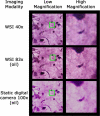Review of Telemicrobiology
- PMID: 26317376
- PMCID: PMC4808477
- DOI: 10.5858/arpa.2015-0116-RA
Review of Telemicrobiology
Abstract
Context: Microbiology laboratories are continually pursuing means to improve quality, rapidity, and efficiency of specimen analysis in the face of limited resources. One means by which to achieve these improvements is through the remote analysis of digital images. Telemicrobiology enables the remote interpretation of images of microbiology specimens. To date, the practice of clinical telemicrobiology has not been thoroughly reviewed.
Objective: To identify the various methods that can be employed for telemicrobiology, including emerging technologies that may provide value to the clinical laboratory.
Data sources: Peer-reviewed literature, conference proceedings, meeting presentations, and expert opinions pertaining to telemicrobiology have been evaluated.
Conclusions: A number of modalities have been employed for telemicroscopy, including static capture techniques, whole slide imaging, video telemicroscopy, mobile devices, and hybrid systems. Telemicrobiology has been successfully implemented for several applications, including routine primary diagnosis, expert teleconsultation, and proficiency testing. Emerging areas of telemicrobiology include digital plate reading of bacterial cultures, mobile health applications, and computer-augmented analysis of digital images. To date, static image capture techniques have been the most widely used modality for telemicrobiology, despite newer technologies being available that may produce better quality interpretations. Telemicrobiology adds value, quality, and efficiency to the clinical microbiology laboratory, and increased adoption of telemicrobiology is anticipated.
Figures



References
-
- Kaplan KJ, Weinstein RS, Pantanowitz L. Telepathology. In: Pantanowitz L, Tuthill JM, Balis UGJ, editors. Pathology Informatics Theory & Practice. ASCP; Canada: 2012.
-
- Cornish TC, Swapp RE, Kaplan KJ. Whole-slide imaging: routine pathologic diagnosis. Advances in anatomic pathology. 2012;19:152–159. - PubMed
-
- Pantanowitz L, Sinard JH, Henricks WH, Fatheree LA, Carter AB, Contis L, Beckwith BA, Evans AJ, Lal A, Parwani AV, College of American Pathologists P, Laboratory Quality C. Validating whole slide imaging for diagnostic purposes in pathology: guideline from the College of American Pathologists Pathology and Laboratory Quality Center. Archives of pathology & laboratory medicine. 2013;137:1710–1722. - PMC - PubMed
-
- Williams S, Henricks WH, Becich MJ, Toscano M, Carter AB. Telepathology for patient care: what am I getting myself into? Advances in anatomic pathology. 2010;17:130–149. - PubMed
Publication types
MeSH terms
Grants and funding
LinkOut - more resources
Full Text Sources
Medical

